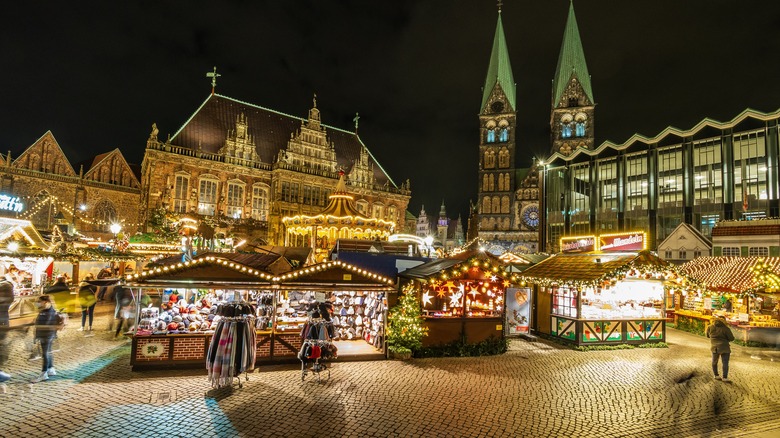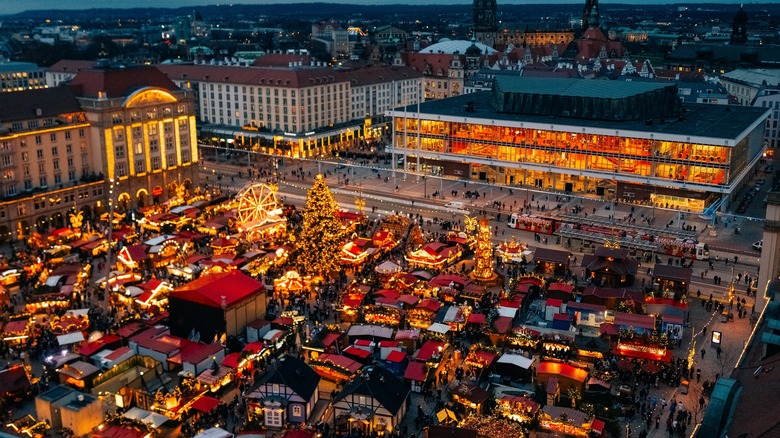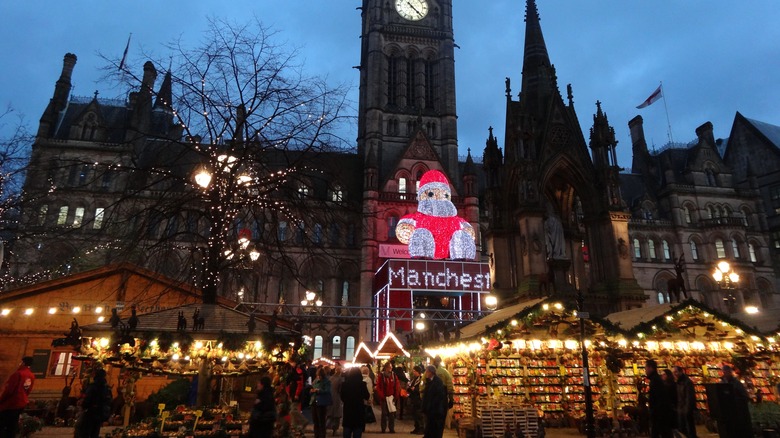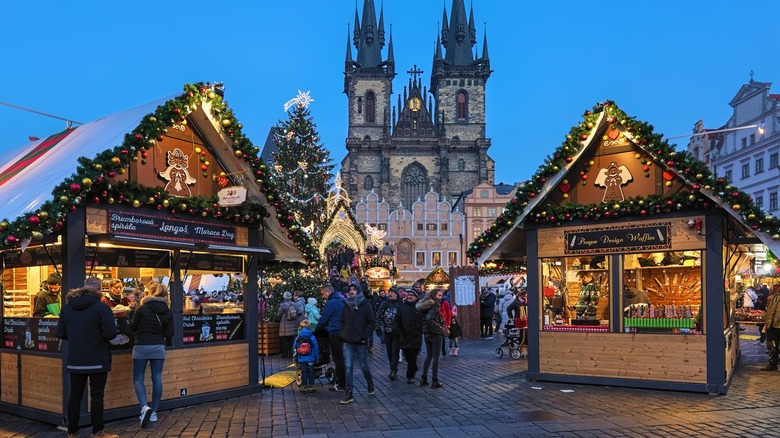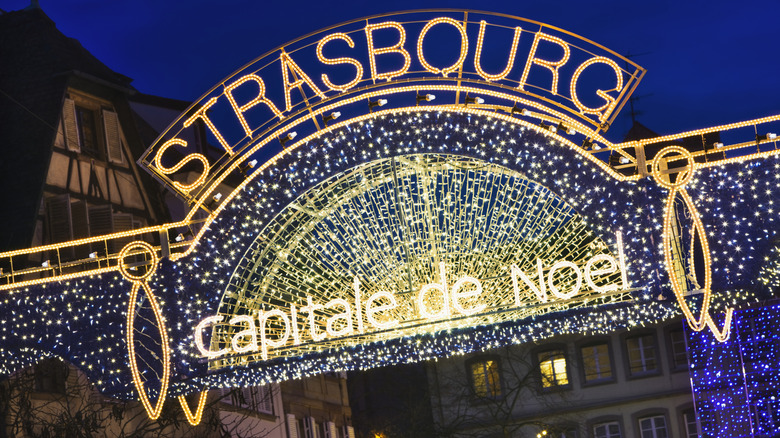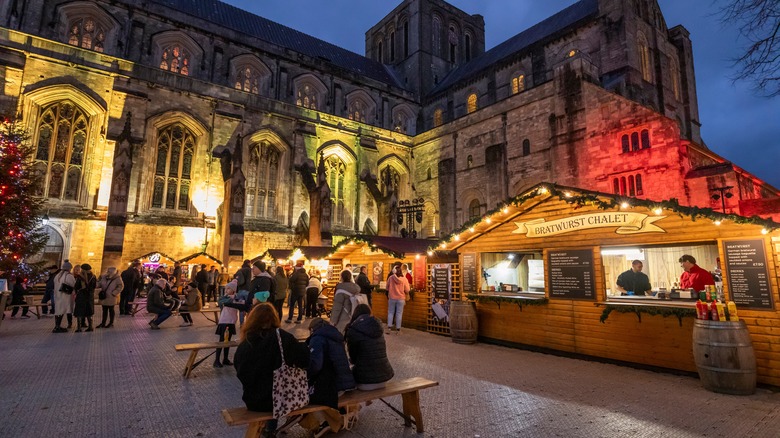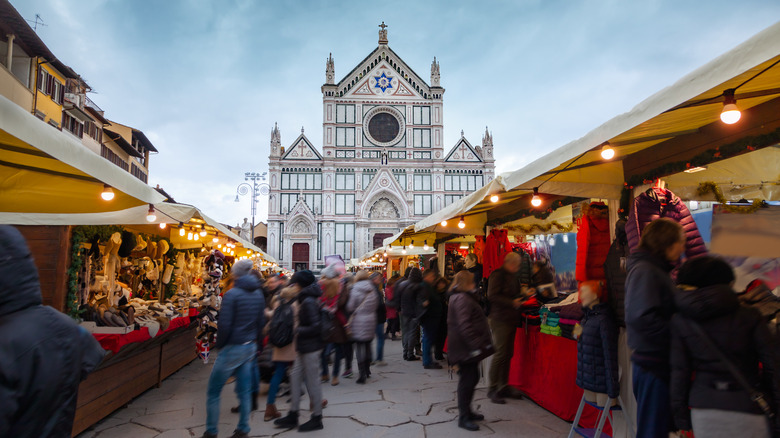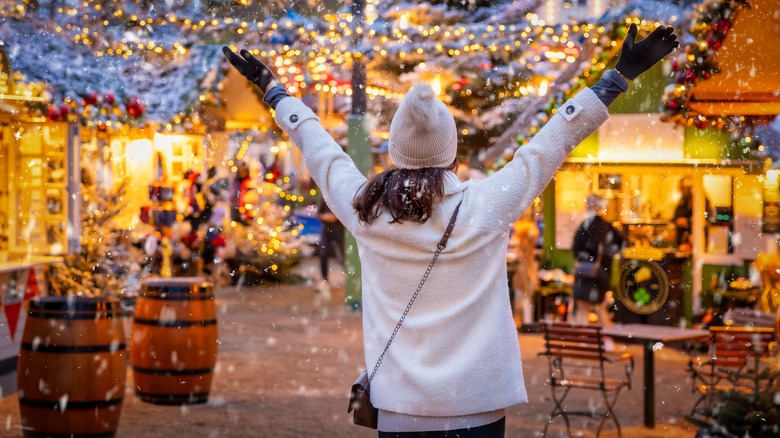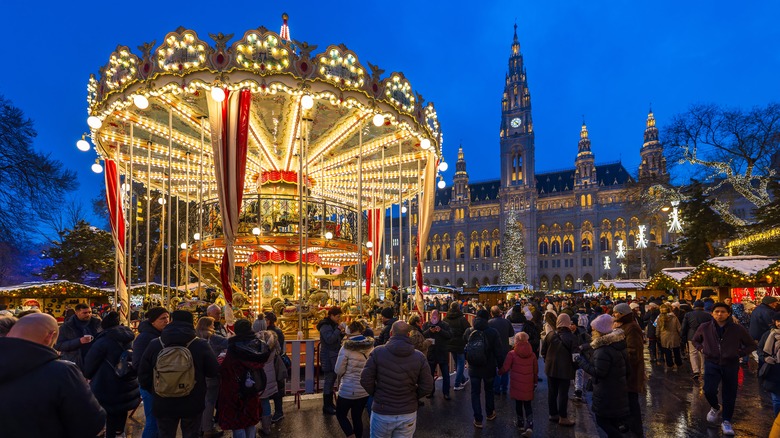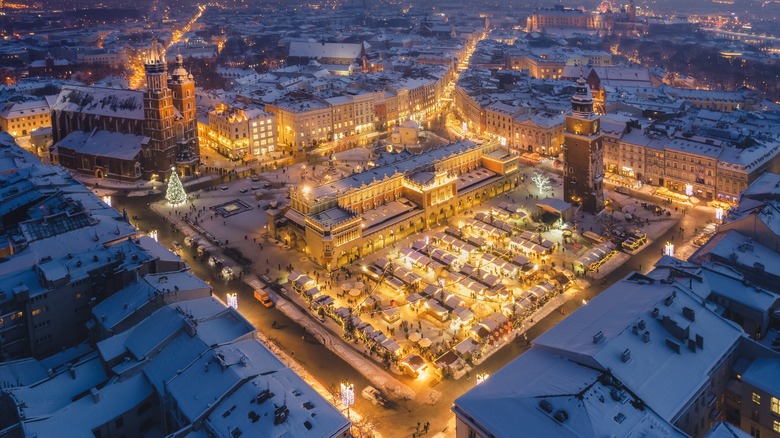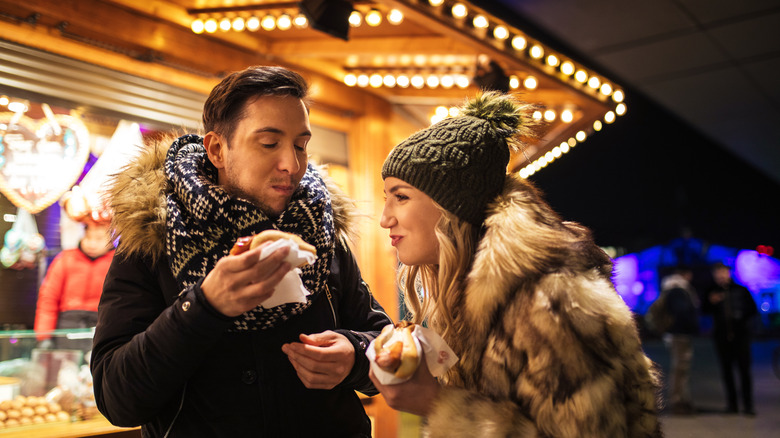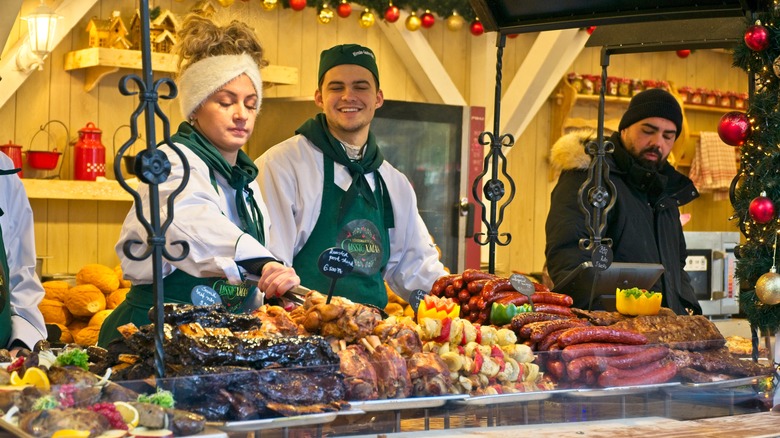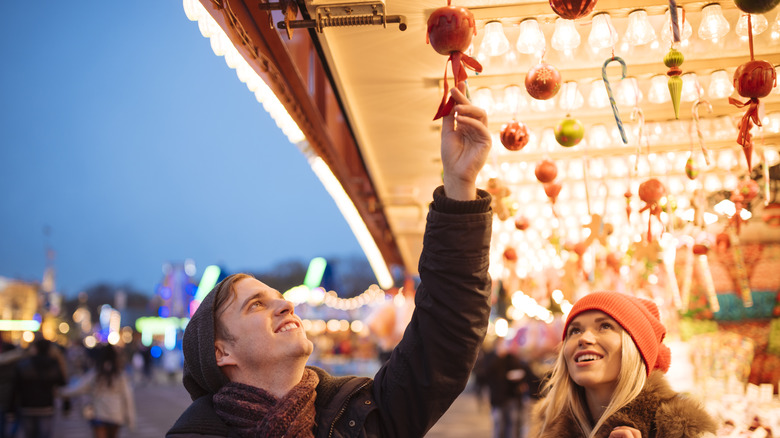The 12 Best Christmas Markets Across Europe
Christmas is a tale of two celebrations. It's the second most important date in the Christian Calendar — after Easter — and holds spiritual meaning to billions of people across the globe. Yet, it is also a secular celebration. Many of its more familiar trappings trace their origins back to pagan rituals, and across the world, many non-Christians observe the practice of gift-giving, family dinners, and decorated houses.
Meanwhile, Christmas markets often feel like a distillation of the holiday experience. They trace their origins back to 13th-century Vienna when the first 14-day December fair was authorized by a presiding duke. While not specifically linked to yuletide, its creation set a tradition for midwinter markets that would later become known as Christkindelsmärik — or market of the child Christ.
Today, Christmas markets are found all over the world. Many have borrowed heavily from their Germanic forebears, although most have peculiarities distinct to specific regions. They are places to congregate, enjoy music, eat food, and make merry. They also serve as hubs to buy festive presents, handmade decorations, and other craft items. And while there are many fantastic Christkindelsmärik dotted across the U.S., there is still something to be said for the ancient markets of old Europe. Here, then, are some of the best, whether you're enjoying the European Christmas market season with Viking cruise lines or just as a checkmark on your festive itinerary.
Dresden, Germany
Dresden sits hard against the meandering curves of the Elbe just a few short miles from the Czech border. The capital of Saxony, the city suffered greatly during the war but has since rebuilt much of what was lost. Ever a city of art and culture, Dresden also happens to be home to the oldest Christmas market in the world.
The claim is contested, of course, but certain facts are beyond dispute. The Striezelmarkt — as it is called — began as a one-day market back in 1434, although its association with Christmas at the time is somewhat tenuous. The word Striezel refers to a cake called Stollen, a kind of sweet, pastry filled with marzipan and dusted with sugar. The cake predates the market itself and although strongly associated with Christmas in the modern period, this was not always the case, muddying the claim that Dresden's Christmas market is the oldest.
Still, even those who dispute the superlative readily acknowledge its pedigree. Traditions abound; wooden huts serve mulled wine, bratwurst with spicy mustards, freshly baked cinnamon pretzels, and Käsespätzel — a dish of fried onions and melted cheese. There are also cheesecakes, and gingerbreads that come in all shapes and sizes, and of course, stollen, sold by the loaf or slice. Crafts are also on display. Dresden lace — made of densely threaded patterns woven in silk, cotton, or linen — is a much-beloved attraction, as are the festive candle stalls, nativity displays, menagerie of themed decorations, and impressively ancient Ferris wheel.
Manchester, United Kingdom
Manchester might not sound like the most obvious place for a world-class Christmas market. A former center of cotton production, it still bears the scars of its 19th-century manufacturing past. Still, in recent years, urban renewal has brought life, industry, and a fresh sense of pride that has infused the municipality with an infectious vibrancy. Indeed, it's an open secret that Manchester is one of England's most underrated cities, bursting with art, shopping, and youthful vibes.
The market runs from December 8 to the 22 — an odd time frame that cuts out Christmas Eve altogether and fully eschews the more traditional twelve days of Christmas model. Still, Mancunians — as the locals are called — really know how to put on a show, and the market is no exception.
It's a decentralized affair with stalls set up across the sprawling city, some nine sites in total. A smaller section dedicated to food usually sets up close to the cathedral, although in recent years, it has begun to spread to adjacent streets. Along Deansgate — the city's fashionable quarter — huts line nearly every side street, and it's here that you will find sellers from continental Europe peddling exotic wares: enormous rounds of parmesan cheese, loaves of stollen, hand-crafted toys, and more.
Piccadilly Gardens — more of a central hub than a homage to horticulture — offers the largest of the spaces devoted to the markets. It burns with activity, the smell of sizzling treats, and the jingle of festive carols. Infamous for its inclement weather, those who anticipate rain rather than snow are unlikely to be disappointed and are free to enjoy some of the best shopping in the U.K. outside of London itself.
Prague, Czech Republic
Prague is a city of five neighborhoods and is a quaint destination, nicknamed "the City of a Hundred Spires," thanks to multiple beautiful buildings around. At Christmas, it comes alive with not one but two markets.
The first of these is located in the city's Old Town Square which is itself famous for its stunning architectural facades, astronomical clock, and Baroque Church of St. Nicholas. The second takes place in Wenceslas Square named after the good king who looked out across the city during the feast of St. Stephen. The King is a genuine historical figure, and the square named in his honor is one of the most beautiful in all of Europe, despite its humble origins as a 14th-century horse market.
Both open towards the end of November and run until January 6 – and both are equally worthy locations for their respective markets. Brightly decorated huts line the plazas selling all manner of festive treats. Sweet pastries, known as chimney cakes, are served warm with ice cream or chocolate sauce, gingerbread is ever-present, and at night, the whole place comes alive with festive music and a canopy of twinkling lights. Savory delights are also on offer: smoked meats are served with dumplings, pigs are roasted on spits, and a traditional, festive, fish soup known as rybí polévka is ladled into bowls from bubbling cauldrons and slurped down as people peruse the crafts on display.
Strasbourg, France
Spend some time between French and German cultures in this inviting, one-of-a-kind city — Strasbourg. Originally a German city, it changed hands in 1681, came back into the German fold in 1871 after the Franco-Prussian War, and then finally became a French city again after World War I.
Christkindelsmärik first appeared in Strasbourg in 1570 — making it the oldest in France — and is so famous across Europe that the city itself is sometimes referred to as the capital of Christmas. Such a moniker might well have been confirmed upon the city by the residents themselves, and yet, it is hard to deny that the place is infused with yuletide spirit.
A thirty-metre-tall tree forms the centerpiece of the market, and around it, you'll find scattered huts selling all manner of festive goodies. These chalets, 300 of them in total are stocked to the brim with bredele, — a kind of medieval cookie laced with licorice — vats of near-obligatory mulled wine, hand-made tree decorations, and many other crafts, treats, and novelties. Carol singers are omnipresent, and although snow is not guaranteed during the November 27 to December 27 market season, things tend to feel crisp and Christmassy regardless.
Winchester, United Kingdom
It's challenging to choose between the many excellent Christmas markets in the U.K. since there are so many standouts up and down the country. Still, few who have visited Winchester — the nation's former capital — would deny that its offering is one of the very best.
The market centers around Winchester's famous Cathedral — an 11th-century Gothic masterpiece of circumspect design. Wooden Chalets open their shutters on November 22 and — as is often the case with British Christmas markets — close for business just shy of Christmas Eve. Proximity to this place of worship adds an ecclesiastical feel to the proceedings, and while the scent of cinnamon and mulled wine permeates the air, the sound of Christmas carols joined by the soothing melodies of people at worship creates a unique ambiance.
Over 400,000 people visit this market every year, and it's no task to figure out why. Walking through the market, sampling goods, and gathering presents creates a nostalgia for a holiday season of the past, the kind familiar via old movies, tales told by elderly relatives, or faded Christmas cards of yore.
Florence, Italy
There is rarely any need for an excuse to visit Florence — a historic gem, and the most walkable city in the world that it is — but if ever you find yourself in need of one its Christmas market offers all the incentives you could ask for. To start with this is another ancient affair – the market traces its origins back some 500 years, and its pedigree shows in the market's adherence to conventional Christmas tropes. The whole affair takes place in the piazza of the Basilica di Santa Croce — a stunning gothic edifice overlooking an enormous, vibrant square in the heart of the city.
Many of the booths and chalets that fill the square are staunchly Germanic in nature. Beer, Bratwurst, and Chimney cakes — or Kürtőskalács as they are known — rub shoulders with traditional nativity scenes, craft items, and hand-made children's toys.
Interspersed between such traditional fare are items with a distinctly Italian twist. There are rounds of fine cheese, chocolatiers, local chandlers, and even vendors selling winter clothing and jewelry, alongside the occasional English stall hawking mince pies and sweet preserves.
Salzburg, Austria
The Saint Nicholas' Market in Salzburg is another entry in the 500-year club. Known locally as the Nikolaimarkt, this seasonal event originally adhered to the strict Christmas calendar of the time, operating for two weeks before and two weeks after St. Nicholas Day, which falls on December 6.
Today it operates as it has for the last fifty years, as a traditional-to-a-fault Christkindelsmärik of the Austrian persuasion. It takes place in the shadow of the stunning Salzburg Cathedral — the largest Baroque church north of the Alps — and opens its doors in late November, staying open until New Year's Day.
Everything you'd expect from a market so steeped in ritual is on display here. Bands play familiar festive tunes, the scent of warm punch fills the air, and thousands of lights glimmer in the twilight as revelers gather to soak up the atmosphere. There are strudels to sample, horse-drawn carriages to ferry you across the city, and other extraordinary events to enjoy.
One such spectacle, the oddly titled Krampus Run, is a particular delight. This ancient custom involves a parade of locals dressed in shaggy belts and terrifying masks. The titular Krampus is a folk-lore demon who punishes children at Christmas time and as good-natured cosplayers run through the market, they jangle bells in an ostensible attempt to ward off evil spirits.
Copenhagen, Denmark
Copenhagen's reputation as something of a foodie mecca, eco-friendly hotspot, and city of exquisite taste makes it an excellent place to visit year-round. At Christmas time, however, the sights and sounds of a city that goes all in on the festive experience bring an added incentive.
Indeed, during the long nights of December and early January, even the amusement park at Tivoli Gardens transforms into a breathtaking winter wonderland, razor-focused on generating what the locals refer to as hygge, a word that describes a feeling of contentment and coziness.
The city's location in northern Europe helps create a seasonal ambiance and although snow is not guaranteed, you may get lucky. Certainly, it's cold enough for outdoor ice skating, and an artificial rink in front of the Tivoli Concert Hall is a popular attraction that brings a Hollywood sense of unreality to the proceedings. A second rink — in the heart of the city also runs through the holiday period.
Adventurous souls can try their hand at ice swimming — a local custom that is not for the faint-hearted — but for those who prefer a more sedate experience, there are vendors abound. A local drink known simply as glögg is reminiscent of a mulled wine, though it is served with a spoon so you can enjoy the edible ingredients floating within. Meanwhile, at the Hans Christian Andersen Market, you can wander around decorated huts looking for souvenirs and perhaps even meet the city's most famous resident, Hans Christian Andersen, or at least, an actor willingly portraying him.
Vienna, Austria
Vienna is rightly thought of by many as the most beautiful city in Europe, with mouth-watering cakes, and stunning architecture — you can also experience Vienna's unforgettable wine culture, in this untouristed area. Fittingly for the capital of Austria, it's also no slouch when it comes to celebrating Christmas.
The most famous — and best market — is found at the Rathaus Platz, the enormous square that sits in front of the town hall. Here, you will smell the chestnuts as they roast, sample the finest strudel, and enjoy a hot spiced punch known as Weihnachtspunsch. There are, of course, bratwurst to try, spätzle — a traditional Austrian noodle dish — and dozens of booths displaying ceramics, candles, wooden nativity figurines known as Krippenfiguren, and more.
Snow Globes — or Schneekugel as they are known — are a particular feature here as they are a Viennese invention and something of a city-wide obsession. They are often of very fine quality and make for excellent souvenirs.
The popularity of the Vienna markets means that they do tend to get quite busy, especially during the run-up to Christmas day. Still, the Christkindlmarkt itself opens early on November 15 and runs until December 26, so there are plenty of opportunities to experience all it has to offer.
Krakow, Poland
Krakow — the youthful charming city known as the Boston of Poland per Rick Steves — is just a two-hour flight away from London, so if you're visiting over the holiday period a quick jaunt to its market comes highly recommended. Held in the city's stunning main square — Rynek Główny — the fair offers as authentic a European yuletide experience as you are likely ever to find.
There's a definite emphasis on food and drink here, with mulled wine and beer being firm favorites. Chalets serving grilled meats are everywhere, complemented by stalls serving hot soups that help combat the intense cold you'll find in Krakow during winter months. The upside to the cold is that snow is all but guaranteed, and few things enhance the Christmas feel of a place more than a light dusting of fine white powder
You'll also find bigos in prodigious quantities. A Polish delicacy that loosely translates as hunter's stew, it's made with sausages such as kielbasa and two types of cabbage, at least one of which is pickled; it has a sour, meaty taste that you'll ever love or despise, but it's well worth a try, regardless.
Berlin, Germany
Unsurprisingly, the capital city of Germany has a number of incredible Christmas markets, over 100 of them in fact. Indeed, there are so many that during the month of December the entire city pivots towards something of a Christmas overload.
With so many places to choose from, anyone keen on exploring all that the city has to offer is spoiled for choice. Popular locations include the Lucia Christmas market, which sets up stalls in front of an old brewery; the Alexander Platz market in the heart of the city, which is famous for its fairground rides; and, the Ferris wheel-dominated market by the city town hall.
Regardless of the location, you'll find plenty to keep you occupied. Light shows, street performances, and festive carol singing form part of the backdrop. Meanwhile, stalls serving mulled wine, hot pretzels, and a plethora of sausages and Kartoffelpuffer — a kind of potato pancake served with apple sauce — round out most evenings for those brave enough to endure the crisp Berlin winter air.
Budapest, Hungary
The Advent Feast at the Basilica in Budapest won the Best Christmas Market in Europe award by European Best Destinations in 2019, 2021, 2023, and 2024, so it's little wonder that it made this list. As with other locations, Budapest actually offers several markets, some of which blend into one another to help create a continuum of festive atmospheres that are hard to resist.
The city is really two separate entities — Buda and Pest — separated by the Danube, though connected via a myriad of bridges. Still, the usual suspects are on display regardless of which side of the river you are on: mulled wine, chimney cakes, and gigantic bratwursts abound, but Hungarian twists to the proceedings spice things up. Goulash is ubiquitous, and the craft fairs focus on embroidered cloths, mittens, wooden ornaments, and leatherwork.Christmas cruises along the river are also very much a thing, and at night, the city shines with a million lights, and festive scents drift between its two halves, making for an unforgettable experience that is sure to leave a lasting impression.
Methodology
Over the past few decades, I've been fortunate enough to have visited all of the markets on this list and, in many cases, experienced them more than once. I took time to go through some old memories but also checked online for positive reviews of more recent travelers in order to provide a more up-to-date overview of the scene.
